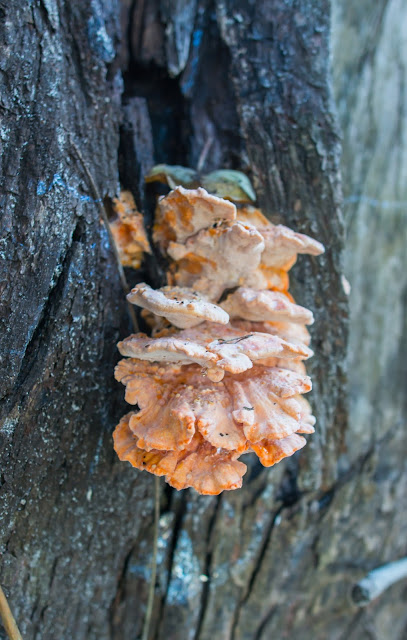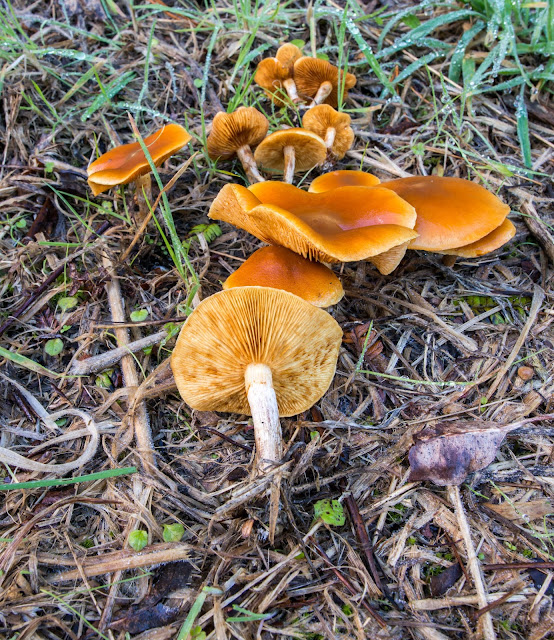Once a dense forest of Koa, mamane, and ʻohiʻa lehua, the Polipoli Spring State Recreation Area is composed of 10 acres of the Kula Forest Reserve. When the park was established many of the native trees were removed. However, in the 1930s the the area was reforested with pines, eucalyptus, tropical ash, cypress, China-fir, and redwood. Due to the elevation (6,200 feet), Polipoli Spring State Recreation Area can actually get pretty cold (temperatures can reach freezing at night). When we headed up at 9 am, there was frost on the grasses and trees, and the mud puddles were crusted with ice. The Jeep was for the clearance and 4 wheel-drive needed to get through some of the holes in the dirt road, and some of the switchbacks at elevation without anything but sheer mountain out the window were a bit terrifying for me, but Robert was laid back about it all, and even had fun driving. We walked a 5-mile loop around a few trails, passing through dense stands of eucalyptus, thimbleberry thickets, assorted conifers planted in rows, into low-hanging clouds that would white out the trail, and by hills heavily blanketed in moss.
Before we got to the parking lot at the top of Polipoli, we passed a couple of familiar fungi on the drive up. First was a Laetiporus gilbertsonii, a relative of our eastern choice edible Laetiporus sulphureus, growing on eucalyptus. Even though it exuded juice when cut, it was as hard as wood. Due to its condition and suspicion in causing upset stomachs because of substrate, we didn't collect it for consumption. Then we passed some Hypholoma fasiculare growing roadside in some wood chips, another we recognize from our cooler, wet autumn season in Connecticut.
Starting out on the grassy portion of the trail, we ran into this butterscotch-colored beauty, possibly one of the Gymnopilus species? Here you can also see the just-melted dew covering the grass.
This is another one we recognize from home, Tricholomopsis rutilans, common name plums and custard. It is usually found growing attached to underground conifer roots, even though it appears to originate in grass.
Plenty of down dead wood up at Polipoli to support saprobic fungi. The cooler temperatures at elevation provided us with some familiar fungi we find in temperate Connecticut, like these two crusts, Phlebia tremellosa and Stereum hirsutum.
This puffball appeared similar to one of our pigskin puffballs, except for the extensive pseudo-stem. Our Mushrooms of Hawaii book IDs this as Scleroderma verrucosum due to the pink staining when the peridium is cut.
This brightly colored and small (most specimens were about 1 cm wide) polypore is the highly photogenic Favolaschia calocera. First observed in Madagascar, it has recently spread around the world and mycologists fear that it may be displacing native fungi species as it spreads through the paleotropics. Once Robert first noticed it on decayed twigs and fern stalks and we knew what to look for, we all suddenly spotted it often.
Chroogomphus sp. is a fungi we found a few years ago when making our first attempt to ascend to Polipoli (in a regular rental car, we never made it past the first 200' on the dirt road before bottoming out and turning around). Known to be associated with conifers in winter in California, this was likely introduced with the planted conifers. This may be C. vinicolor or C. rutilans, we didn't collect a specimen and scope the spores (hey, vacation!).
There are not too many Boletes in Hawaii, beyond a few Suillus and the elusive coconut-associated bolete, Pulveroboletus (Buchwaldoboletus) xylophilus. This Suillus pungens was a big surprise, as it isn't listed in the Mushrooms of Hawaii book, but it IS listed in the Mushrooms of the Redwood Coast, another book we own. This mushroom is normally associated with Monterey Pines, and was likely imported by accident with the conifer plantings done in the 1930's as well.
And as we were heading out of Polipoli in the late afternoon, Gillian asked a question from the back seat of the Jeep as we were driving along the dirt road that was cut into the grassy embankment, "Hey, isn't that a morel?". Haha, very funny, you can't fool us. BUT IT WAS. The weather at Polipoli mimics our southern New England weather in May very well: cold nights, warm days, and plenty of rain, so it makes sense. Morchella are reported in Hawaii, but fruiting in a scattered manner and difficult to see because of the dense undergrowth.
 |
| Planted conifers in Polipoli |

















No comments:
Post a Comment